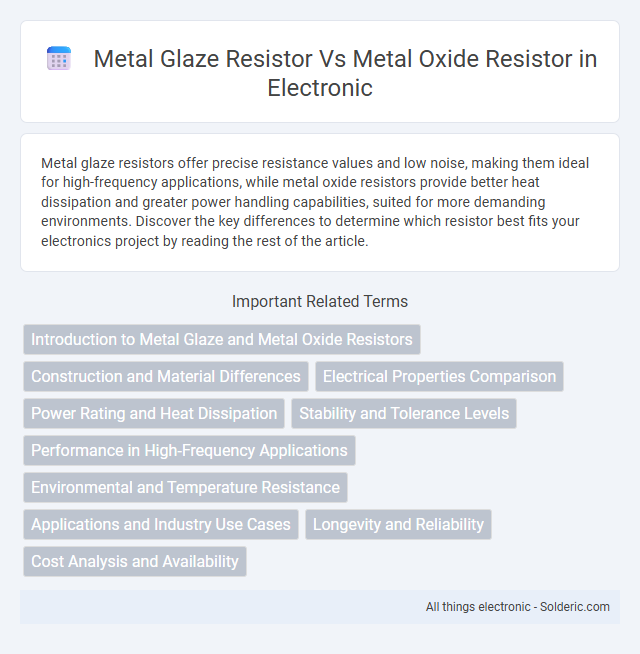Metal glaze resistors offer precise resistance values and low noise, making them ideal for high-frequency applications, while metal oxide resistors provide better heat dissipation and greater power handling capabilities, suited for more demanding environments. Discover the key differences to determine which resistor best fits your electronics project by reading the rest of the article.
Comparison Table
| Feature | Metal Glaze Resistor | Metal Oxide Resistor |
|---|---|---|
| Construction | Thin metal film glaze on ceramic core | Thick metal oxide film on ceramic core |
| Resistance Range | 1 O to 10 MO | 1 O to 100 MO |
| Power Rating | Up to 2W | Up to 5W or more |
| Tolerance | +-1% to +-5% | +-1% to +-10% |
| Temperature Coefficient | +-100 ppm/degC | +-200 ppm/degC |
| Noise | Low noise | Higher noise than metal glaze |
| Applications | Precision circuits, low noise applications | High power, high voltage circuits |
| Durability | Moderate, less heat resistant | High, better heat and surge resistance |
Introduction to Metal Glaze and Metal Oxide Resistors
Metal glaze resistors utilize a thin layer of metal particles embedded in a ceramic matrix, offering precise resistance with low noise and excellent stability in high-frequency applications. Metal oxide resistors feature a metal oxide film deposited on a ceramic base, providing superior temperature stability, high surge tolerance, and enhanced durability under harsh environmental conditions. Your choice depends on specific circuit requirements, where metal glaze excels in precision and metal oxide shines in ruggedness and thermal performance.
Construction and Material Differences
Metal glaze resistors feature a resistive film made by depositing a thin layer of metal glaze onto a ceramic core, offering high precision and stability. Metal oxide resistors use a metal oxide film, such as tin oxide, applied through a thick-film process onto a ceramic substrate, providing higher thermal stability and power ratings. The difference in materials results in varying electrical characteristics, with metal oxide types generally offering better performance in high-temperature and high-power applications compared to metal glaze resistors.
Electrical Properties Comparison
Metal glaze resistors exhibit excellent electrical stability and low noise due to their finely dispersed metal film on a ceramic core, making them ideal for precision applications. Metal oxide resistors offer superior heat resistance and higher power ratings, maintaining stable resistance values even under thermal stress. Your choice between the two should consider the required tolerance, temperature coefficient, and power dissipation characteristics essential for your electronic circuit's performance.
Power Rating and Heat Dissipation
Metal glaze resistors typically offer moderate power ratings up to 2 watts with efficient heat dissipation due to their ceramic base and thin film metal glaze coating. Metal oxide resistors generally support higher power ratings, often exceeding 5 watts, and exhibit superior heat dissipation capabilities because of their robust metal oxide film and larger surface area. The enhanced thermal stability of metal oxide resistors makes them preferable for high-power applications demanding reliable heat management.
Stability and Tolerance Levels
Metal glaze resistors offer higher stability with tolerance levels typically ranging from +-1% to +-5%, making them suitable for applications requiring precise resistance values over time. Metal oxide resistors provide excellent stability under thermal stress and environmental conditions, often with tighter tolerance options around +-1%, ensuring reliable performance in harsh environments. Both resistor types maintain low drift rates, but metal oxide resistors generally outperform metal glaze resistors in longevity and tolerance consistency under extreme conditions.
Performance in High-Frequency Applications
Metal glaze resistors typically exhibit superior performance in high-frequency applications due to their low parasitic inductance and capacitance, resulting in minimal signal distortion and noise. Metal oxide resistors, while robust and stable under high power, often present higher inductive reactance which can affect the accuracy of signals at elevated frequencies. Your choice should consider the frequency range and sensitivity of the circuit to ensure optimal impedance characteristics.
Environmental and Temperature Resistance
Metal glaze resistors offer moderate environmental resistance but can degrade under prolonged exposure to moisture and extreme heat, whereas metal oxide resistors excel in high-temperature stability and resist corrosion in harsh environments. Their oxide film composition provides superior thermal stability, ensuring reliable performance in automotive and industrial applications where temperatures frequently exceed 150degC. Choosing a metal oxide resistor enhances your device's durability and longevity in demanding conditions, making it ideal for applications requiring robust environmental and thermal resistance.
Applications and Industry Use Cases
Metal glaze resistors excel in precision applications such as audio equipment, instrumentation, and telecommunications due to their stability and low noise characteristics. Metal oxide resistors are preferred in power electronics, automotive, and industrial machinery for their high surge tolerance and superior temperature resistance. The choice between these resistors hinges on specific industry requirements, balancing precision and durability across varying operational environments.
Longevity and Reliability
Metal glaze resistors offer high reliability due to their excellent thermal stability and resistance to environmental factors, resulting in longer operational life in precision applications. Metal oxide resistors provide enhanced longevity under high voltage and surge conditions because of their robust oxide film, which improves insulation and heat dissipation. Both types deliver dependable performance, but metal oxide resistors tend to outperform metal glaze resistors in harsh environments requiring superior durability.
Cost Analysis and Availability
Metal oxide resistors typically offer a more cost-effective solution compared to metal glaze resistors due to lower manufacturing complexity and higher production volumes, resulting in better availability across various electronic component suppliers. Metal glaze resistors, while providing superior precision and stability, tend to be pricier and less commonly stocked, which can impact procurement timelines. Your choice between the two should weigh the budget constraints against project requirements for availability and performance.
Metal glaze resistor vs metal oxide resistor Infographic

 solderic.com
solderic.com